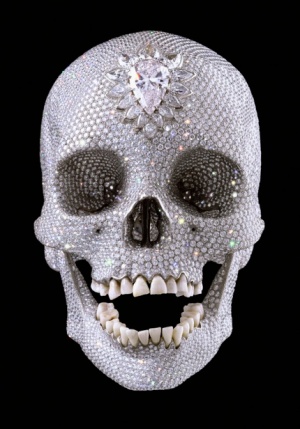Damien Hirst's work 'For the Love of God' and Mercantilism
1. Define the work, giving details of form and materials.
'For the Love of God', this is a amazing, jaw dropping piece of art created by Damien Hirst. the form of this art is a platinum casted human skull. but it is not that simple. This human skull has something a little more eye catching to it. The skull is encrusted with 8.601 diamonds. A pear shaped diamond located on the skulls forehead is the centerpiece of the work this is included in the 8.601 diamonds on the skull.
2. What does the work mean? What is Damien Hirst communicating in the work?
Hirst's art is commonly surround by the thought of death, this proven true in this artwork. This Piece, being an 18th century skull that was purchased in london. Mexican Skulls encrusted in Turquoise was where the idea erupted from. In an interview he explained, 'I just want to celebrate life by saying to hell with death. What better way of saying that than by taking the ultimate symbol of death and covering it in the ultimate symbol of luxury, desire and decadence? The only part of the original skull that will remain will be the teeth. You need that grotesque element for it to work as a piece of art. God is in the details and all that.' The New York Times also interviewed Hirst, he explained, 'I remember thinking it would be great to do a diamond one, but just prohibitively expensive, then i started to think, maybe thats why its a good thing to do. Death is such a heavy subject, it would be good to make something that laughed in the face of it' Here Hirst tells us that the skull is to ironically brighten/lighten a dark subject. I guess using diamonds was the right material then.
3. How does Hirst's diamond encrusted skull relate to Mercantilism and to conspicuous consumption?
According to the online dictionary, mercantilism also called mercantile system, a theory prevalent in Europe during the 17th and 18th centuries asserting that the wealth of a nation depends on its possession of precious metals and therefore that the government of a nation must maximise the foreign trade surplus, and foster national commercial interests, a merchant marine, the establishment of colonies, etc. This can be related to Damien Hirst's work as the is creating a work to be sold for a larger amount it was made for, this resulting is a profit further realting to wealth. This is common in mercantilism such as exports minus imports. As Hirst was able to create such an expensive artwork with the materials purchased himself, it is clearly shown that he must have an extravagant amount of money, and to do something as amazing as this, it is a clear way to show his wealth.
4. How much did the work cost, and how much was it sold for, and who bought it?
The work that was produced in 2007 containing 8,601 diamonds was $20million to produce, including materials and fabrication. The pear shaped diamond on the forehead of the life sized skull alone is to be work $4.2million. According to Londons White Cube Gallery where the work was displayed announced that the 'British artist Damien Hirst Diamond encrusted skull sold for $100million dollars.' This artwork was the most expensive artwork ever sold by a living artist and broke records. A group of anonymous investors purchased the work and it is believed the plan to resell the work later for an increased price.
5. What are some of the differing opinions of the journalists in the newspaper and blog articles?
What did they think of the work?
What did they think of the work?
When researching i found two prominent opinions, one being a work of genius from one of Britain's most talented artist, the other being a tacky symbol of excess and an art market being 'drunk with money'. But every critic has an opinion of Hirst's diamond encrusted skull, questioning the authenticity of the piece. Hirst hired technicians to create the piece taking 18 months, but Hirst stands by his working making the concept of the art important rather than the work itself. Many believe that the money spent on the work is beyond belief and could have been spent on many other things, they also have said the same work could have been created for less. But on the argumentative side of that, the work would not have the same extravagance to it if it had not had its worth. Robin Simon, editor of The British Art Journal stated ‘all of Hirst’s works are stunts, but this one is just a more expensive stunt. It’s vacuous nonsense.'
6. Based on your research, what is your opinion of the work, as an object or a work of art.
6. Based on your research, what is your opinion of the work, as an object or a work of art.
My personal opinion on this art work seems to be the same of Robin Simon. As much as i appreciate the time, thought, effort and money put into the artwork, i understand the extravagance and i believe that if i was to see this in person my views may change, but for now i believe that the monetary value has exceeded the worth of true art. I believe this art is memorable for the price rather than the talent and it doesn't have the true beauty and value that other artworks contain.
http://dictionary.reference.com/browse/mercantilism?s=t
http://www.nytimes.com/2007/06/03/magazine/03Style-skull-t.html
http://www.artknowledgenews.com/Damien_Hirst_For_The_Love_Of_God.html



